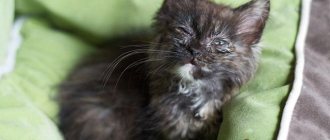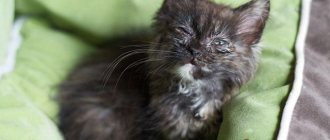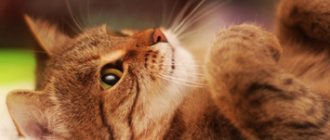If the Sphynx's eyes fester, this may be a symptom of conjunctivitis, blepharitis, or entropion. In addition to suppuration, the inflammatory process is accompanied by photophobia, unnatural squinting of the eye, and swelling. At the first symptoms, you should take your pet to a veterinarian, who will prescribe medications or perform surgery.
Veterinarians warn that purulent eye diseases in most cases lead to panophthalmitis, so treatment of inflammation should begin quickly.
How to treat festering eyes in cats?
Cats are the cleanest pets, washing themselves thoroughly after each awakening.
They lick the fur and use their paws to “remove” dried brownish crusts from the corners of their eyes. Usually the owner does not notice such formations, but when a cat’s eyes fester, discharge from them and souring become constant and clearly visible. A small amount of discharge from the eyes in healthy cats is considered normal. Cat tears are usually reddish or grayish in color and appear for a variety of reasons. Discharge from a cat's eyes can be sporadic and rare. Perhaps the animal’s eyes began to water because there was a defensive reaction to dust particles that had landed on the surface of the visual organ.
https://www.youtube.com/watch?v=https:accounts.google.comServiceLogin
This situation is not dangerous, so the owner should not worry about it. It’s another matter when a pet’s eyes fester, thick yellow or green pus oozes out of them. This is already a cause for concern.
In any case, it is necessary to understand the causes of the pathology, and then begin therapy. So why do cats suffer from festering eyes?
If a cat’s purulent discharge from the eye is characterized by a clear or watery consistency, then this symptom often indicates mechanical injuries to the visual organ or allergic reactions. A characteristic sign of such discharges are gray or reddish crusts that dry out in the inner corners of the eyes.
Thick, yellowish or greenish discharge indicates that your pet has an infection (caused by bacteria or fungus). The animal definitely needs the help of a veterinarian, because such a pathology cannot be cured at home. Self-medication can further worsen the animal’s health.
When a cat's eyes are very festered, it is necessary to check for systemic or eye diseases. Eye injuries, conjunctivitis, diseases of the eyelids or cornea can provoke the appearance of suppuration in the area of the animal’s visual organs. A cat’s eyes also fester because her body is affected by chronic viral infections, plague or panleukopenia.
Injuries or bruises to the eyelids also cause purulent discharge from the cat's eyes. An animal can injure the visual organ during a fight with another cat, while climbing trees (with branches) or as a result of careless games. Often the inflammatory process after injury spreads to the eyeball.
Chemical, temperature or traumatic effects on the eyelids can provoke the development of blepharitis and, as a result, suppuration of the cat’s organ of vision. Viruses, microbes, and fungal infections enter the damaged eye, causing the eyes to fester. Poor nutrition, household chemical products, poor quality sleep and even the individual structure of a cat’s muzzle - all these factors also become an explanation for why a pet’s eyes fester.
Colds or allergies. If a cat sneezes and its eyes fester, this is an alarm bell. The animal probably caught a cold. This reaction of the pet’s body may be to an infection or allergic irritant that has entered the body. But sometimes sneezing in cats is caused by dust getting into the nose.
A good owner will quickly see that his pet's eyes are festering. He should definitely be alerted to additional signs indicating serious problems with the cat’s visual organ. These include:
- the animal behaves restlessly, often rubs its inflamed eye with its paw, the cat loses its appetite; the fur around the affected eye becomes brownish and matted; sometimes the cat’s body temperature rises, he tries to hide in a dark, secluded place; eyes that fester, become reddish or cloudy; the animal blinks frequently; in front of the cat’s eyes, due to the continuous leakage, a dense brownish crust forms, which does not allow the pet to open them completely; increased sensitivity to light (the cat develops photophobia, characteristic of pathological processes in the cornea).
We suggest you familiarize yourself with the causes of watery eyes in a cat, how to treat it.
If viral diseases develop in the cat’s body, then suppuration of the eyes is often accompanied by a prolonged and persistent fever.
As soon as the first alarming symptoms appear, take your cat to the veterinarian. He will prescribe a set of tests, make the correct diagnosis based on their results and prescribe treatment. To diagnose conjunctivitis, the veterinarian does tests on the mucous membranes of the affected eye.
If a kitten's eyes are festering, the owner should visit a veterinarian with his pet. This is especially important in cases where the discharge from serous turns into mucous or mucopurulent. The owner of the animal must understand that the conjunctiva and cornea of the eye in cats are very delicate areas.
If pathological factors affect them for a long time, and no treatment is carried out, then these tissues undergo irreversible degenerative transformations. As a result, the cat’s vision is severely impaired. To prevent this from happening, the owner should know what to do at home when the cat’s eyes fester.
- Pay attention to how long the cat's eyes fester. If purulent discharge continues for more than 2-3 days, and unsightly crusts constantly appear in the corners of your pet’s eyes, examine the animal’s condition more carefully. See if the cat's eye is injured or if a foreign body has entered it. Only in such cases can the animal be treated at home, without the help of a veterinarian. If you suspect that your pet's eyes are festering due to an allergy, you need to find out what caused the reaction. Perhaps the cat’s food has been changed or the animal is constantly near flowering plants with a pungent odor.
Actually, this is all that the owner of a furry pet can do to cure it at home. In more severe cases, you need to take the cat to the veterinarian.
Treatment for purulent eyes in a cat is developed depending on the reasons for which the problem arose. If an animal's eyelid is swollen and one eye is festering, this is likely due to injury or a foreign body entering the visual organ. The first thing the owner should do is rinse the affected eye, removing accumulated discharge and dried crusts. Such events are carried out every day until the cat’s eyes stop festering.
To wash a sore eye, you can buy a special solution at the pharmacy or prepare it yourself. At home, you can wash your cat’s eyes with the following compounds.
- A solution of distilled water and table salt. For 1 liter of liquid you need to take 0.5 tsp. salt and bring the mixture to a boil. Immediately before use, the composition is cooled. If a cat's eyes are festered, it is recommended to treat them with just such a saline solution. The only exceptions are situations where suppuration occurs due to exposure to allergens. Then you cannot add salt to clean water. Strong infusion of tea. To prepare it, it is better to use distilled water and whole leaves. Tea leaves have excellent disinfectant properties. In addition, it contains caffeine, which helps to narrow blood vessels and reduces symptomatic manifestations of allergic reactions. Are your cat's eyes festering as a result of a bruise? Use hydrogen peroxide to wash them. In case of severe suppuration, before visiting the veterinarian, rinse the animal’s eyes with chamomile decoction, furatsilin or boric acid. Furacilin is taken at 0.02%, and boric acid is dissolved in 0.5 liters of water.
We invite you to read Why cats constantly meow for no reason
If you wipe your cat’s eyes at home, divide the treatment solution into 2 parts in advance (each of them will go to one eye). Use a separate cotton pad for each eye. Soak the dried crusts so that the animal does not feel pain when you remove them.
Causes of pus in the eyes
The appearance of pus in the eyes indicates a bacterial infection, which can be primary or secondary (due to allergies or a viral disease).
Allergy
With allergies, mucus occurs due to inflammation of the conjunctiva (the mucous membrane of the eye) - allergic conjunctivitis. In this case, the Patient may experience itching, a feeling of sand in the eyes and notice decreased vision. Bacteria, which are normally present on the skin and ocular surface, under conditions of inflammation can multiply rapidly and cause the appearance of purulent discharge.
Infection
There are two main infectious diseases
, which are accompanied by purulent discharge - barley and bacterial conjunctivitis.
Bacterial conjunctivitis occurs due to an infection that has entered the mucous membrane of the eye and caused severe inflammation. Often this process is signaled by vivid symptoms: the eyeball turns red and becomes swollen, burning sensation, discomfort and blurred vision occur.
With barley, purulent discharge increases gradually. The appearance of painful swelling on the eyelid is characteristic. Pus is released when the inflamed lesion is opened.
What should the owner do if the animal’s eyes are suppurated?
If your pet's eyes are festering, drops can also be used for treatment. In this case, it is important to know which formulations are best to use and how to carry out this procedure correctly. To treat the eyes of a cat, various types of drops are used. For example:
- "diamond eye" chloramphenicol; sulfacetamide.
Even if an animal’s eye is very festering, you can help it with drops without leaving your home. Adhere to the following rules to perform the procedure effectively.
- Lay the cat on its side, turn its head up. If your pet has a restless and violent character, it must be immobilized before eye drops are administered. Use a large sheet or towel for changing. Instill the medicinal solution with your pet's eye slightly open. During the procedure, hold the cat's face with your hand so that he does not shake it. When the medicinal composition hits the cat's eyeball, it will blink, and thereby contribute to the uniform distribution of the drug over the entire surface of the eye. After instillation, blot your pet's eye with a dry cloth or cotton pad.
Remember that the above-described manipulations with drops will not help cure the underlying disease, but will help relieve acute symptoms of eye suppuration. If your cat’s visual organs are severely festered, only an experienced veterinarian can cure this pathology. Eye treatment for cats should be timely. Only under this condition can your pet’s vision be saved.
Types of purulent discharge
If the owner of a furry cat notices purulent discharge from the eye of his pet, he first needs to determine its nature. This will further allow the veterinarian to make an accurate diagnosis and differentiate less dangerous diseases of the animal’s visual organs from more serious ones. The type of discharge will also help determine whether pathogenic microflora is involved in its appearance.
Discharges from the eyes of cats are as follows.
Mucopurulent. They arise due to damage to the eye by bacterial infections. The color of the purulent fluid varies from dark yellow to green. A characteristic sign is the presence of a smell of heat. Serous. The discharge has a watery consistency and is almost always transparent and straw-colored. Sometimes they may have a pinkish tint.
https://www.youtube.com/watch?v=ytabout
We suggest you read What to do when a pug's eye falls out
Serous inflammation is often the initial stage of complex pathologies. Also, the appearance of serous discharge may indicate the presence of an allergic reaction or viral infection. The appearance of such discharge is associated with exposure to chemicals or cigarette smoke. Mucous. Light and viscous secretions of a protein structure, odorless.
Most often, mucous discharge indicates a chronic type of influence of various irritants or powerful allergens, pathological conditions of the cornea or tear ducts. If a cat has untreated eye injuries, then there is a high risk of developing purulent inflammation of the mucous membranes of the eye.
Symptoms of adenoviral infection in children and their frequency of manifestation
Once in the child’s body, the virus enters the stage of the incubation period, that is, maturation. For 4 to 14 days, more often 5-7 days, the child may not show any signs of the disease. The disease manifests itself acutely or increases gradually.
External symptoms that any doctor can identify include2:
- Copious mucous discharge from the nose;
- Flushing of the pharynx or redness of the mouth;
- Swelling of the tongue;
- Development of pharyngitis;
- Change in the appearance of the tonsils;
- Red eyes and conjunctivitis;
- Increasing intoxication of the body - lethargy, weakness, headache, loss of appetite and nausea;
- Diarrhea, especially in young children;
- Temperature rises to 38–38.5° C.
After many years of studying various manifestations of acute respiratory viral infections, including adenovirus infection, doctors have deduced the frequency of occurrence of certain symptoms, which may indicate a specific virus.
- The most common symptom is fever, which occurs in 96% of cases.
- In 88% of cases with adenovirus infection, pharyngitis develops, and its duration is on average 5 days.
- Cough occurs in 78% of children with adenovirus. The likelihood of a dry and wet cough is approximately the same.
- In 67% of cases, rhinitis with mucous discharge from the nose is observed.
- Enlargement of the cervical lymph nodes is observed in 60% of patients.
- When listening to the lungs, wheezing is detected in 36% of cases.
- In 28% of children, there is a slight enlargement of the tonsils.
- A third may experience complications. The inflammatory process can develop into bronchitis, laryngotracheitis and pneumonia.
- Conjunctivitis is quite rare, but a clear sign of adenovirus infection, which occurs in every fifth person.
- Intestinal disorders have been reported in 22% of children, with a clear predominance in early childhood, in newborns and up to three years of age3.
Parents should pay attention to three stages of symptoms in their child, which are listed in the memo below. After the first segment, you need to seek medical help:
- The first manifestations of adenoviral infection. The child developed a fever, stopped being active, and began complaining of headaches.
- Distribution to all respiratory organs. Coughing, wheezing, sore throat appear, shortness of breath, runny nose occurs, and the child’s voice changes.
- Further progression of the disease. The eyes turn red, and the mucous membrane becomes inflamed (conjunctivitis), and gastrointestinal problems, diarrhea and vomiting may begin.
The following forms are distinguished according to severity:
- A mild form of the disease involves mild symptoms and a slight increase in temperature. In most cases, the disease subsides within a week.
- The moderate-severe form is characterized by severe symptoms of intoxication, fever and chills. The temperature reaches 38° C or more, the disease lasts a long time and complications are possible.
- In severe cases of the disease, the child’s body is subjected to a serious test. The disease almost always leads to complications - bronchitis develops, the liver can increase in size. With this type of disease, hospital treatment will likely be required.
Rinse the cat's eyes: useful tips
If a kitten's eye is swollen and festering, rinsing should be done carefully, having first taken care of your safety. During the procedure, the pet will be nervous and struggle, so it should be well secured (or use the help of a second person who will hold the animal). The best option is to swaddle the cat with a towel or diaper so that only the head remains outside. Please also adhere to the following recommendations.
- Rinse each eye with solution from a separate container. Twist the cotton wool into a tight rope, dip it in a warm broth (medicinal solution), and squeeze it onto the animal’s festering eye. When the pet's eyes are completely cleared of purulent discharge, apply tetracycline ointment (1%) under the cat's eyelid. To do this, pull back the animal’s lower eyelid and, using a special spatula, place the composition on its inner surface. Then close your cat's eye completely and massage it lightly. This will help the product to be distributed evenly. To further enhance the effect of using the ointment, preheat the tube with it in your hands. But if the cat is very nervous, then you should not apply the ointment under the eyelid (this can lead to injury to the organ of vision).
Prevention measures
There are several useful tips that will help prevent suppuration of the cat's eyes.
- Check your pet regularly and take your cat to the veterinarian's office for preventative purposes. Monitor your animal's behavior while walking to prevent eye injuries. If your pet has an “explosive” character, walk him on a harness so that he doesn’t get into fights with other cats. If the animal does get into a fight with its relatives, examine it carefully and treat the affected areas around the eye and the rest of the body with hydrogen peroxide. If a cat's eye becomes infected after a fight, be sure to rinse it with plain water or chamomile infusion. Carry out the deworming procedure in a timely manner. Worms not only harm the pet, but also poison its body with the products of its own vital activity. And one of the signs of helminth parasitism in a cat’s body is suppuration of one or both eyes at once. For long-haired cats, it is necessary to trim the hair around the eyes for preventive purposes. This will avoid unwanted discharge and will be a good preventive measure against the formation of crusts. If an animal has an injury to the area around the eyes, and this has led to suppuration of the visual organ, the owner needs to monitor the pet’s behavior so that it does not scratch the affected area with its paws. It is better to put an Elizabethan collar on your pet, which is sold in a pet store (if you wish, you can make it yourself).
https://www.youtube.com/watch?v=ytpolicyandsafety
Constant care for your pet and timely treatment of eye injuries will help avoid serious consequences of eye suppuration.
Diagnosis and treatment of pus in the eyes
Elimination of any symptom is always interconnected with finding out the reasons for its occurrence. It is not enough to simply get rid of the external signs of the disease - it is necessary to eliminate its original source.
Treatment of purulent discharge can be carried out by washing and instilling drops. The main goal in each case is to prevent infection from entering the healthy eye, so all procedures are carried out separately. Depending on the reasons for the appearance of pus, antihistamines, antiseptics, antibiotics and anti-inflammatory drugs can be used.











